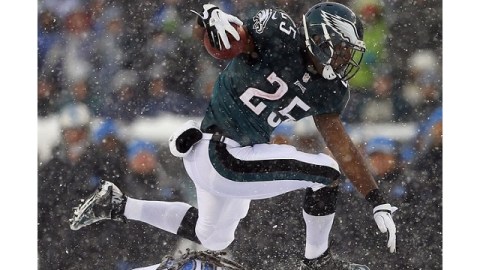How Football is Like a Modern Painting

As the Denver Broncos and Seattle Seahawks prepare to meet this Sunday in Super Bowl XLVIII at MetLife Stadium, you’ll hear a lifetime’s worth of metaphors for football, many of which have already been catalogued and parodied in George Carlin’s classic routine “Football versus Baseball.” One metaphor you’re less likely to hear is how football is like a modern painting, but that’s a common metaphor in one of the most unusual, but most insightful sports books written about the game—Nicholas Dawidoff’s Collision Low Crossers: A Year Inside the Turbulent World of NFL Football. If you’re a fan of football or just a fan of interesting, quirky writing that gets at the creative artistry of any activity, including sports, Dawidoff’s Collision Low Crossers is the book for you.
Dawidoff takes his title from the phrase football defensive coaches give to the policy of colliding with any receivers in your area if they’re still within five yards of the line of scrimmage. Beyond five yards, such collisions are illegal, but that tight window of high-speed, violent opportunity in limited space and time neatly encapsulates the world of football that Dawidoff experienced in while spending a year with the New York Jets from the draft through training camp through the long, tough season of 2011. Journalists have immersed themselves in the day-to-day drama of professional football going back to the days of George Plimpton’s Paper Lion, but Dawidoff gets even more literary and artistic in his sports metaphors than Plimpton, who once wrote for the literary journal The Paris Review.
Although the later sections dealing with the players on the team provide some interest, you get a feeling that Dawidoff identified much more closely with the coaches he spent time with in the draft room and the preseason planning meetings. “It was up to the coaches to reimagine the familiar thing they saw on film in a new light,” Dawidoff writes of the Jets’ coaches studying the film of future adversaries. “This was one of the ways in which the sensibility of football coaches, who drew up plays for a living, had much in common with that of fine artists. Cezanne slashed the paintings that dissatisfied him. Giacometti gasped, swore furiously, and descended into melancholy or anguished as he painted James Lord’s portrait, often screaming with rage at the canvas and then scrubbing it and beginning anew. On film, the players were the coaches’ creations.” As much as it is the players who make the plays, it’s the coaches who put them in the position to make those plays. The struggle to take the raw material of player personnel and turn it into a work of football art—the touchdown, the sack, the pick six—comes alive in vivid, fascinating, paradigm-changing detail in Dawidoff’s book. Writing of Mike Pettine, then the Jets’ defensive coordinator and now the new coach of the Cleveland Browns, Dawidoff remarks, “To him football film was a Brueghel painting, a canvas strewn with fascinating little human interactions about which he was now the narrator.” I never saw a Brueghel painting in the controlled chaos of professional football before, but, thanks to Dawidoff, I’m having trouble seeing anything else.
Dawidoff’s artistic eye falls on and transforms everything from the smallest detail to the biggest names. The laminated play sheets coaches clutch nervously and frantically ponder during games become mini Mondrian paintings thanks to their blocked color scheme. Watching New England Patriots’ head coach Bill Belichick “[a]t the press podium and along the sideline,” Dawidoff sees a man “at a remove, a man whose present distance allowed others to discuss him in the way artists spoke of their own quarter-lit masters—the way jazz musicians thought of Buddy Bolden, actors about Stanley Kubrick.” A shameless name-dropper, Dawidoff nevertheless never drops a name without a specific and persuasive purpose, which separates his book from so many other guts and glory sports writing.
There is, of course, guts and glory, but Dawidoff never delves into the machismo of the sport without maintaining his critical eye. “Because football was so permissive of violence,” he writes, “it did have qualities of being in a state of nature, a place where you could be someone else, feel immortal.” The unnaturalness of that natural feeling tricks players and fans into falling in love with the game sometimes at the cost of those involved. “What strange creatures brothers are!” Dawidoff quotes quirkily from Jane Austen’s Mansfield Park in a heartfelt chapter on the brotherhood of football men, focusing on Jets’ head coach Rex Ryan and his twin Rob, also a professional football coach. They learned the trade at the feet of their father Buddy, a former head coach himself. Rex’s brotherly loyalty to his staff, especially Pettine, offers a humane counterpoint to the meat grinder reality of the game, which chews up and spits out young men faster than you can tear your ACL. As much as these stories demonstrate how football can be a shared passion between brothers and even fathers and sons, it also, especially in Pettine’s case, becomes a way in which “tough love” coaching replaces and almost negates the perceived love between parent and child.
From the lingering homophobia poisoning the sport (captured graphically by a scene in which coaches wear shirts and sweats into a sauna rather than the customary towel) to the opportunities the game offers those at the lowest rungs of the social ladder (“The Jets, like every NFL team, had many players who had experienced severe trauma as children—a mother who died in childbirth, a father who died of an overdose… The Jets team doctor Kenneth Montgomery told me that in all ways football players were naturally selected to endure pain.”), Dawidoff gives an unflinchingly honest look at the game. The Jets should be commended for allowing Dawidoff such total access to their world. Readers are lucky that Dawidoff was more than up to the challenge.
Football itself stands at a crossroads. The Frontline documentary “League of Denial” made it impossible for anyone to deny the long-term effects of playing football on the human brain and body. Despite rule changes aimed at safer play, football’s become a sport fewer parents are allowing their children to play. Yet, as Sunday’s Super Bowl will once again demonstrate, the league remains awash in mind-boggling profits. We want to look away, but we can’t. As much as I prefer baseball personally, I can’t deny the grace and beauty of an image such as the Philadelphia Eagles’ LeSean McCoy seemingly flying through the snow in a game earlier this year (shown above). Nicholas Dawidoff’s Collision Low Crossers: A Year Inside the Turbulent World of NFL Football reunites the visceral appeal of football with its intellectual side. Brainy almost to a fault, Collision Low Crossers crashes through the stereotypes of the dumb jock playing the dumb game and helps us see the complexity and mental concentration behind the muscle. Just as a great painting touches the head and heart at the same time, football, at its best and when it exemplifies the best values it claims to extol, makes us feel and think simultaneously. Dawidoff’s artistic collision with the sport of football may just save the game from itself.
[Image: The Philadelphia Eagles’ LeSean McCoy running through the snow during a 34-20 victory on December 8, 2013 versus the Detroit Lions. Image source.]





